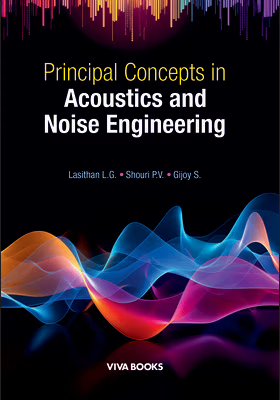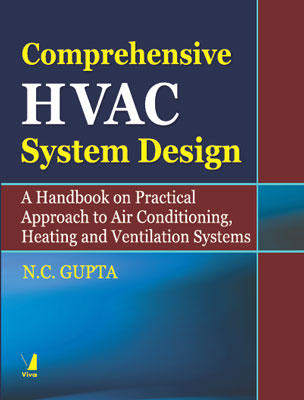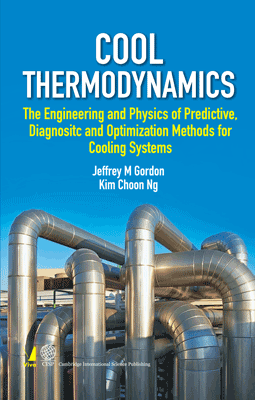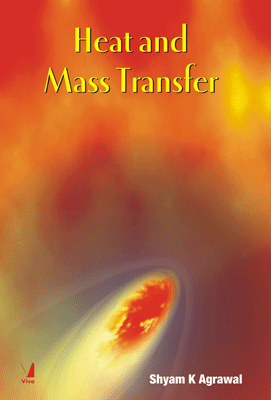Comprehensive HVAC System Design
Comprehensive HVAC System Design
A Handbook on Practical Approach to Air Conditioning, Heating and Ventilation Systems
₹1,795.50 ₹1,995.00 Save: ₹199.50 (10%)
Go to cartISBN: 9788130934594
Bind: Hardbound
Year: 2016
Pages: 524
Size: 184 x 242 mm
Publisher: Viva Books Originals
Sales Territory: Worldwide
Description:
The estimation of requirements for air conditioning, heating, and ventilation is a relatively simple task. In contrast, the decision regarding appropriate equipment capacity and suitable system design is a complex process. This is so because calculations normally account for the worst peak load conditions, when in reality the system has to operate at loads varying between 50 and 90% most of the time. The actual quantum percentage or diversity applicable varies according to varying climate conditions or choice of application. Any HVAC system needs a building envelope for its installation and active support of several associated services and material, like (i) a building that needs to be conditioned, (ii) interior layout to add aesthetics to the building, (iii) electrical equipment required to operate the HVAC system, (iv) water circulation system for operation of water-cooled systems, and (v) insulation and acoustics to improve system efficiency while reducing noise and vibration. Keeping these in mind, the present book aims to serve as a comprehensive guide for designing an effective system for heating, ventilation, air conditioning, and evaporative cooling; in essence, it is an effective practical bridge between theory and actual practices in the field. This book brings together relevant data on the theory, the building envelope and combines it with equipment selection, specific building application, and practical system design data. All in all, the book takes a practical approach with specific guidelines on designing any HVAC system. It will be highly useful to both beginners and professionals across the developing world. The book is divided into four parts: Parts I and II provide valuable knowledge to beginners, engineers and architects who are new to HVAC and are keen to understand the basics while Parts II I and IV are more advanced, suitable for practicing engineers and people with some knowledge of the subject.
Part I gives some basic data on refrigerants, refrigerant cycle, psychrometrics of air behaviour and interlinks with civil structure of any building's interior design, as well as information useful for architects to incorporate HVAC in a building, etc. Part II provides valuable information on various HVAC equipment and systems, on the inter-linking topics of electrical equipment and building management system (BMS), as well as on other aspects of building security such as fire detection, access control, CCTV, etc. Part III describes various building applications that can be used effectively in designing a proper system. The system so designed would be relevant to the particular application, such as offices, hotels, hospitals, large gathering places, institutes campuses, etc. It lists out specific inputs for effective design. Part IV contains detailed information via charts, tables, and graphs on relevant ambient temperature conditions, ventilation design, piping design, electrical design, and BMS.
Target Audience:
Comprehensive HVAC System Design is a book that may be expected to be of great value to many engineers and professionals in the HVAC industry as well as to architects and professionals in building services and engineering like building management systems, electrical engineering, fire and security systems and energy efficiency and conservation, to cite a few.
Contents:
PART I: FUNDAMENTALS OF DESIGN
1. Designing a HVAC System • Concept of Design • Factors in Design • Climatic Zones • Psychrometrics • Main Equipment • Associated Equipment • Ancillary Items • Typical Applications • Green Building • Summary • 2. HVAC Fundamentals • Refrigerants: Their Need and Suitability • Refrigeration Cycle • Understanding Air Behaviour • Air Conditioning Systems • Heating Systems • Ventilation: Its Necessity • Air Conditioning vs Heating: Differences • Conclusion • 3. Understanding Psychrometrics? Explaining Psychrometric Chart • Measuring Instruments • Definitions of Properties • Plotting on Psychrometric Chart • Air Conditioning Processes • Sensible Cooling Processes • Evaporative Cooling System • Applications • Dehumidification of Air • Applications of Dehumidification • Mixed Air Humidification (Winter) • 100% Outside Air Humidification • Annexure I(a): Psychrometric Chart Barometric • Pressure 29.92 IN, WG (FPS System) • Annexure I(b): Psychrometric Chart Barometric • Pressure 1 kg/cm2 (SI System) • 4. Building Envelope • Permanent Construction • Temporary Structures • Structural Glazing • Basements • Structural Design for Foundations • 5. Integration with Interiors? Role of Interiors in a Building • Understanding Meaningful Heights • Purpose and Types of False Ceilings • Integration with Other Services • Exposed Design • Summary • 6. References for Architects? Contribution of the Building Design on the HVAC System • Significance of Building Materials • Effect of Glazing • Benefits of Insulation • Sizing Air Conditioning and Ventilation Systems • Air Cooled vs Water Cooled Systems • Types of Air Conditioning Systems • Space Requirement • Sizing Basement Spaces • Sizing Indoor Spaces • Sizing Outdoor Spaces • Annexure I: Heat Addition to Space • 7. HVAC System: An Overview of Design • Sequence of Designing • Outside Conditions • Internal Heat Source • Indoor Air Quality (IAQ) • Inside Design Conditions • Other Factors Affecting Design • Sum Total of Heat Load • Standalone HVAC Equipment • Larger Direct Expansion (DX) Systems • Chilled Water and Hot Water Systems • Evaporative Cooling and Ventilation Systems
PART II: HVAC SYSTEMS AND EQUIPMENT
8. Energy Conservation: Its Relevance • Philosophy of Energy Conservation • Overview on Conservation • Contributing Factors • Energy Efficient Design • Energy Saving Equipment • Maintenance of Systems • Benefits • 9. Direct Expansion (DX) Equipment? Types of Direct Expansion (DX) Systems • DX Units (Air Cooled) • Types of Compressor • Air Cooled Non-ductable Units • Air Cooled Ductable Units • Water Cooled Ductable Units • VRF/VRV Systems • Conclusion • 10. VRF/VRV System and Equipment • Definition of a VRF/VRV System • Types of Indoor Units • Outdoor Units • Refrigerant Piping • Electric Hookup • Air Distribution • Conclusion • 11. Chilled Water Systems: An Overview? Concept of Chilled Water System • Capacity Range • Application Based Design • Major Components • Energy Saving Devices • Ancillaries • Summary • 12. Chilling Units • Types of Chillers • Making of a Chiller (Compressor Type) • Making of a Chiller (Vapour Absorption Type) • Water Cooled Chillers • Vapour Absorption Chillers • Air Cooled Chillers • Making a Choice • 13. Water Circulating System • Planning for a Good Design • Advantages of a Good Design • Types of Pumps • Pump Characteristics • Importance of Proper Selection • Problems with Faulty Selection • Solutions to Avoid Pitfalls • Functions of Circulating Systems • Summary • 14. Water Cooling Devices? Purpose of Water Cooling Devices • Types of Water Cooling Devices • Characteristics of Cooling Devices • Suitability of Cooling Devices • 15. Fans • Types of Fans • Important Characteristics • Fan Balancing • Applications • 16. Air Handling Devices? Defining Air Handling Devices • Functions of Different Components • Types of Air Handling Units • Utility of Air Handling Units • Types of Fan Coil Units • Applications of Fan Coil Units • 17. Thermal Storage Systems • Purpose of Thermal Storage • Defining Thermal Energy • Types of Systems • Functioning of a Thermal Storage System • Benefits • Sizing of a Thermal Storage System • Applications of a Thermal Storage System • Summary • Annexure I • 18. Heating Systems: An Overview? Concept of a Heating System • Heating vs Air Conditioning: Differences • Capacity Range • Types of Heating Devices • Application Based Design • Design Features • Summary • 19. Heating Equipment and Accessories? Types of Heating Systems • Hot Water Generating Equipment • Space Heating Equipment • Accessories for Oil Fired Boilers • Comparison of Boiler Efficiency • Applications • 20. Comfort Cooling Systems and Devices • Defining Comfort Cooling • Cooling Devices • Earth Air Tunnels (EATs) • Comfort in the Monsoons • Applications • 21. Ventilation Systems and Industrial Cooling • Defining Ventilation Function • Ventilation Equipment • Coolers and Scrubbers • Designing Ventilation Systems • Commercial Ventilation • Industrial Cooling/Ventilation • Smoke Exhaust • 22. Energy Saving Devices and Emerging Technologies • Energy Conservation • Energy Conservation Devices • Emerging Technologies • Benefits • Applications • 23. Electrical Equipment and Systems • Fundamentals of Electricity • Sources of Electric Supply • Power Distribution • Electric Switchgear Accessories • Electrical Accessories • Electric Panels • Controlled Devices (Induction Motors) • Low Voltage Devices (LVDs) • 24. Standalone Controls? Defining Standalone Controls • Types of Controls • Functions of Controls • Types of Control Action • Sensors and Controlled Devices • 25. Building Management Systems • Purpose of a Building Management System (BMS) • Defining Building Management System • Objectives of a Building Management System • Functions of a Building Management System • Building Management System Hardware • Functions of Hardware • Control Logic • Applications • 26. Air Distribution Systems and Methods • Good Air Distribution: Its Importance • Evaluating External and Internal Factors • Major Components • Fundamentals of Good Air Movement • Annexure I(a) • Annexure I(b) • 27. Water Circulating Systems and Methods? Piping Systems: Types and Uses • Valves • Main Accessories • Designing Efficient Piping Circuits • Reverse Return Water Flow System • Water Balancing • 28. HVAC: Effects on Fire and Security? Fire and Smoke: A Cause for Concern • HVAC Ducts: A Source of Fire • Areas of Concern • Smoke Evacuation and Control • Smoke Detection Systems • Fire Fighting System • Close Circuit Television (CCTV) System • Other Security Devices
PART III: SPECIFIC APPLICATIONS
29. Offices • Definition of Office • General Description of an Office • Types of Offices • Application-specific Features • Onwards: Actual Design • 30. Hotels • Functions of a Hotel • Walk Through a Hotel • Size Matters • Categories of Hotels • Rating Systems • Operational Activities • Application-specific Features • Onwards: Actual Design • 31. Health Care Facilities? Purpose of a Health Care Facility (HCF) • Glossary of Terms/Activities • Types of Health Care Facilities • Walk Through • Application-specific Features • Onwards: Actual Design • 32. Various Gathering Places • Defining Places of Gathering • Specific Needs • Application-specific Features • Onwards: Actual Design • 33. Video and Recording Studios • Sizes and Functions • Video Studio • Sound Studio • Application-specific Features • Onwards: Actual Design • 34. Clean Rooms? Concept and Purpose of Clean Rooms • Levels of Cleanliness • Typical Features of Clean Spaces • Application-specific HVAC Features • Onwards: Actual Design • Annexure I • 35. Restaurants/Shopping Establishments and Malls • Types of Restaurants • Types of Shopping Establishments • Specific Needs (Restaurants) • Specific Needs (Shopping Malls) • Onwards: Actual Design • 36. Educational Institutes? Types of Educational Institutes • Types of Facilities: Size and Activities • Application-specific Needs • Onwards: Actual Design • 37. Research Institutes • Defining Research Institutes • Supplementary Activities • Specific Needs • Onwards: Actual Design • 38. Pharmaceutical Industry • General Guidelines • Specific Needs • Onwards: Actual Design • 39. Electronics and Other Industries • Variety in Application • Specific Needs • Onwards: Actual Design • 40. Airports • Purpose of an Airport • Range of Activities: Domestic Terminal • Range of Activities: International Terminal • Specific Needs • Onwards: Actual Design • 41. Residential Systems • Types of Residences • Specific Needs (Split System) • Specific Needs (Central System) • Onwards: Actual Design • 42. Onwards: Actual Design • Types of Systems • DX System • VRF/VRV System • Chilled Water System • Chilled/Hot Water Piping • Ducting • Electrical System
PART IV: SYSTEM DESIGN DATA
43. System Design: A Step-by-Step Guide • Sequence of Design • Benefits of Data in Part I • Benefits of Data in Part II • Utilising the Data in Part III • Utilising the Data in Part IV • 44. Heat Loads: The First Step • Getting Started • Orientation of the Building • Calculating the Heat Loads • Process to Follow (Cooling) • Heat Load (Heating) • Heat Load (Evaporative Cooling) • Summary of Results • Related Data • Annexure I: Outside Design Data of Indian Cities • Annexure II: Outside Design Conditions (SAARC, Middle East and South East Asia) • Annexure III: Temperature Deviation Data Chart (Hourly) • Annexure IV: Apparatus Dew Point (ADP) Table • Annexure V(a): Psychrometric Chart Barometric • Pressure 29.92 IN, WG (FPS System) • Annexure V(b): Psychrometric Chart Barometric • Pressure 1 kg/cm2 (SI System) • Annexure VI: HVAC Design Basis • Annexure VII: Common Heat Transmission Factors (U Values) • Annexure VIII: Ventilation System Design Factors • Annexure IX(a): Heat Load Work Sheet • Annexure IX(b): Heat Load Work Sheet (for Computor) • Annexure IX(c): Cooling Load Estimate • Annexure IX(d): Heating Load Estimate • Annexure IX(e): Evaporating Cooling Load Estimate • Annexure IX(f): Heat Load Summary • 45. Selecting an Appropriate System? Assessing the Requirement • Reviewing Available Equipment and System • Choice of System • Summary of System Selection • Annexure: Air Conditioning Plants (FPS and SI Units) • 46. System Selection • Necessary Components • Split System • Ductable Split System • VRF/VRV System • Roof Top Air Conditioner System • Packaged Air Conditioner System • Condenserless Packaged System • Chilled Water System: Air Cooled • Chilled Water System: Water Cooled • Evaporative Cooling System • Ventilation System • Summary • 47. Air Handling Systems • Brief Overview • Air Handling Units (AHUs) • Fan Coil Units (FCUs) • 48. Air Distribution Systems? Benefits of Good Design • Classification of Ducts • Methods of Duct Design • Fundamentals of Duct Design • Appropriate Size Selection • Economics of Good Design • Insulation of Ducts • Acoustic Lining of Ducts • Grilles/Diffusers • Typical Details • 49. Water Pumps • Importance of Pumps • Types of Pumps • Water Flow Rate (Condenser) • Water Flow Rate (Chiller) • Optimising Pump Head • Guide to Good Selection • Conclusion • 50. Water Cooling Equipment • Basis of Selection • Cooling Towers (Sizing) • Other Cooling Devices (Sizing) • Water Consumption • 51. Designing Condenser Water Piping • Purpose of Condenser Water Piping • Factors to be Considered in Design • Procedure to be Followed • Friction Table • Annexure I: Condenser Water Piping Design • 52. Designing Chilled Water Piping? Purpose of Chilled Water Piping • Factors to be Considered in Design • Water Velocity • Procedure to be Followed • Pipe Sizing • Annexure I: Chilled Water Piping Design (Single Pumping) • Annexure II: Chilled Water Piping Design (Primary/Secondary Pumping) • Annexure III: Water Pipe Sizing Chart • 53. Designing Hot Water Piping • Purpose of Hot Water Piping • Factors to be Considered in Design • Water Velocity • Procedure to be Followed • Pipe Sizing • Annexure I: Hot Water Piping Design (Single Pumping) • Annexure II: Hot Water Piping Design (Primary/Secondary Pumping) • Annexure III: Water Pipe Sizing Chart • 54. Ventilation and Evaporative Cooling? Purpose of Ventilation • Ventilation Rates • Ventilation of Diesel Generator Set Rooms • Water Consumption in Evaporative Coolers • Usefulness of Evaporative Cooling • Summary • Annexure I: Staircase Pressurisation Method • 55. Electrical System in HVAC • Details of Electrical Panel (Single Item) • Details of Electrical Panel (Multiple Items) • Importance of Capacitors and Control Circuits • Finer Points of Power Cabling • Importance of Earthing (Grounding) • Conclusion • 56. Scope of Building Management Systems • Scope of Building Management System • Preparing Data Point Summary • Integrating Other Services • Usefulness of Logic • Summary • Annexure I: Data Point Input/Output (I/O) Summary • 57. Insulation and Installation • Types of Insulation • Properties and Uses of Insulation • Installation of Equipment • Tips for Operation and Maintenance • Annexure I: Sample Plant Room Layout • Annexure II: Sample AHU Room, Cooling Tower and • Air Cooled Chiller Layout • 58. General Information • Air Conditioning of Server Rooms • Water Quality and Treatment • Refrigerants: Their Environmental Effects • Temperature Conversion Table • Useful Tips • Conversions and Abbreviations • Liquid Tank Details • Weights and Volumes of Water Pipes • Selection of Valves and Accessories
Details of Industry Partners • Index
About the Author:
N.C. Gupta is a renowned Consultant in the field of Heating, Ventilation, Air Conditioning and Refrigeration (HVAC&R) and is well-known both in India and abroad. He graduated in Mechanical Engineering from Oklahoma State University. Oklahoma, USA and then worked in Blue Star Ltd., a leading HVAC Company, for over a decade, before becoming an independent Consultant in 1972. He is widely acknowledged as a pioneer in this field who had the vision and conviction to step into a profession which was relatively unknown at that time. He has over 50 years of experience in designing HVAC systems of all possible types. He has more than 1,000 HVAC system designs to his credit, in fields as diverse as offices, hotels, hospitals, educational institutes, shopping malls, airports, etc. He was formerly President of ASHRAE's India Chapter and has been active with both ASHRAE and its Indian counterpart ISHRAE. He has to his credit the design of several innovative products for the HVAC industry which are now being widely manufactured and used in India. He has given talks at numerous forums in India on the subjects of HVAC design and energy conservation and has delivered guest lectures at various educational institutions. He has been felicitated with several awards and honours from diverse organisations in recognition of his immense contribution to the HVAC industry in India.





